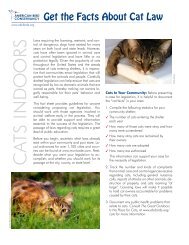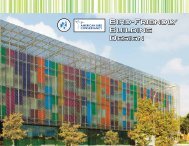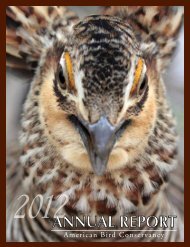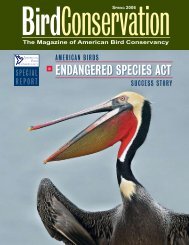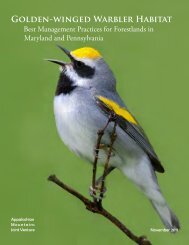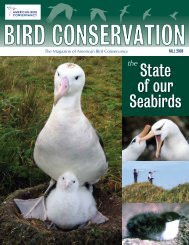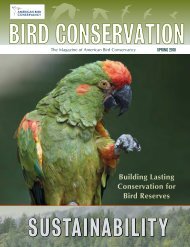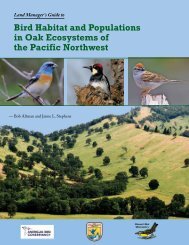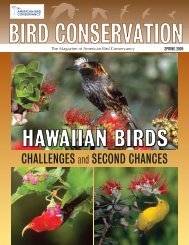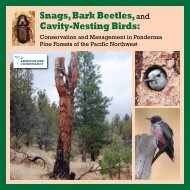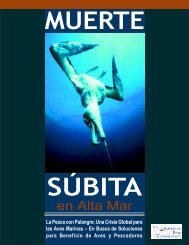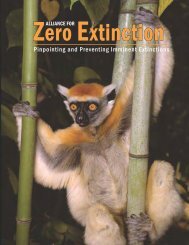Top 20 Most Threatened Bird Habitats in the U.S. - American Bird ...
Top 20 Most Threatened Bird Habitats in the U.S. - American Bird ...
Top 20 Most Threatened Bird Habitats in the U.S. - American Bird ...
Create successful ePaper yourself
Turn your PDF publications into a flip-book with our unique Google optimized e-Paper software.
with change. An antpitta deprived of humid forestconditions <strong>in</strong> <strong>the</strong> small swath of <strong>the</strong> Andes <strong>in</strong> which itevolved has little chance of survival.Photo: FWSSo, as we humans cont<strong>in</strong>ue to convert habitat toconditions that superficially seem to be of greatershort-term benefit to us, we split <strong>the</strong> bird world <strong>in</strong>tothose that thrive with new opportunities and thosethat wi<strong>the</strong>r <strong>in</strong> <strong>the</strong> face of change. <strong>Bird</strong> conservationis simply an attempt to provide for <strong>the</strong> needs of thatever-<strong>in</strong>creas<strong>in</strong>g latter group.The k<strong>in</strong>d of change that we call habitat loss is conversionof habitat conditions required by specialized birdspecies to conditions <strong>in</strong> which those birds cannotsurvive. This is <strong>the</strong> fundamental cause of populationdecl<strong>in</strong>es <strong>in</strong> birds.But not all change is bad. Fire, flood, extreme wea<strong>the</strong>r,disease, and urban sprawl may benefit some birds.Clear-cutt<strong>in</strong>g of forests and overgraz<strong>in</strong>g of grasslandswork nicely for o<strong>the</strong>rs. The worst types of change areconversion to agriculture, which tends to be at leastpartially reversible, and conversion to urban conditions,which tends to be permanent.To select <strong>the</strong> <strong>20</strong> most threatened bird habitats,we considered <strong>the</strong> severity of historic habitat loss,current threats to rema<strong>in</strong><strong>in</strong>g habitat, past andongo<strong>in</strong>g restoration efforts, and <strong>the</strong> existenceof protected areas such as parks, grasslands,wildlife refuges, and reserves. ABC’s Green List(www.abcbirds.org/greenlist.htm) was used togauge <strong>the</strong> value of habitat for conservation priorityspecies. The number of Green List species (which<strong>in</strong>cludes birds listed under <strong>the</strong> Endangered SpeciesAct) found <strong>in</strong> high concentrations weighted <strong>the</strong>importance of <strong>the</strong> habitat for birds.Acorn Woodpeckers: Glen Tepke; TOP ROW: Lawrence's Goldf<strong>in</strong>ch: Glen Tepke; Blue Grouse (recently split <strong>in</strong>to Dusky Grouse and Sooty Grouse): USDA Forest Service;BOTTOM ROW: Burrow<strong>in</strong>g Owl; Black Skimmers: Glen Tepke; Tricolored Heron: Bill Hubick; Western Bluebird: Ashok KhoslaPage 6 of 48



